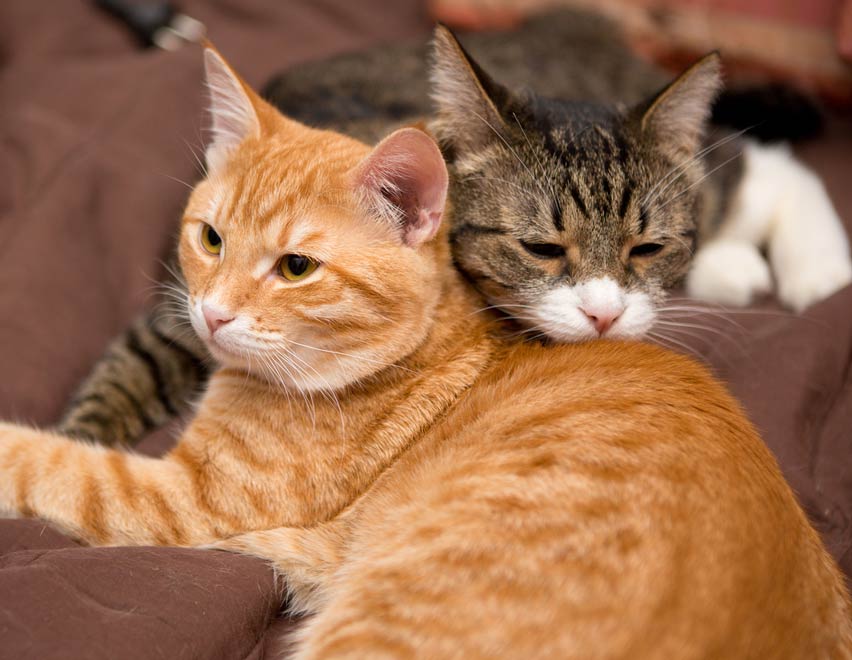How to Introduce a New Cat to a Household that Already Has a Cat

There are many reasons to add a second cat to your household, including to give a home to another homeless cat, to provide a latchkey cat with some feline company, or because of the ever-popular thought: "Why stop at one when two are more fun?"
How Do You Introduce Cats?
"Tabatha, meet Tony, the resident cat. Tony, meet Tabatha, your new feline housemate. I'll leave you two alone so you can get to know one another."
If only it were that simple.
One of the keys to a mutually satisfying multi-cat household is making sure that your current cat and new cat start off on the right paw. This requires some knowledge, forethought, and finesse on your part. Though each cat is unique, fortunately, there are some cat introduction techniques that work on most cats, most of the time. Here are the main steps to ensuring a low-stress transition and lots of happy purrs.
Phase 1: Select a Cat That's Compatible with Your Current Cat
Whenever possible, a high-energy kitten or young cat should be paired up with another high-energy kitten or young cat, so each has a compatible feline playmate. In general, try to match the characteristics of your new cat to those of your resident cat. For example, if the resident cat is older and calmer, he may not appreciate the addition of a rambunctious kitten to his home. Granted, sometimes your new cat will be a stray that finds you rather than the other way around, so you just have to do the best you can. Learn more here: "Best Breeds for Multi-Cat Households."
Phase 2: Prepare for the New Arrival
The following proactive tasks will help the transition to a multi-cat household (or the addition of another cat to a home that already has multiples) go more smoothly:
Make sure the cats each have sufficient territory. Territory, from a feline perspective, is space (horizontal and vertical) and access to prime resources. Prime resources are objects or aspects of life that cats desire strongly on a day-to-day basis. They include:
- Elevated perches (command posts)
- Scratching posts and pads
- Litter boxes
- Window views
- Comfy sleeping places
- Hideaways
- Playtime
- Human attention
Safety Tip:
If the cats will let you, perform cat claw care before their first meeting and periodically as the meetings progress—for extra insurance against injuries to them or you. You could also consider vinyl nail caps for extra protection.
Territory disputes are a common source of friction between cats. Ensuring that the cats feel confident about their access to territory goes a long way toward maintaining peace and harmony.
- Set up a private "welcome home" suite for your new cat so the two cats can have their own space at first. This room should be inaccessible to your resident cat and incorporate all of the important territory and lifestyle elements described above. If you know that the new kitty is used to a specific litter box setup or has favorite toys, scratching posts, or sleeping surfaces, try to include those in the room; the continuity will be comforting to her. Another reason it's important to keep your cats separate at first is because new cats and kittens coming from shelters, breeders, or outside may be carrying upper respiratory infections that aren't apparent right away. Keeping the cats separated will help protect your resident cat from catching anything infectious that the new cat may be carrying.
-
Make sure that your new cat gets a veterinary exam including testing for the feline immunodeficiency virus (FIV), feline leukemia virus (FeLV), and intestinal parasites before coming home. It's also important that your resident cat has had a recent veterinary checkup and is current on the vaccine program you have set up with your veterinarian. If your new cat tests positive for a contagious disease, discuss various options and their associated health and psychological implications for both cats with your veterinarian.
- Spray Feliway periodically in your new cat's room and the rest of the house. Feliway is an artificial pheromone product that often has a calming effect on cats and may ease territory-related anxiety.
Phase 3: The Debut of Cat Number Two
Using the welcome home suite and introducing each cat to the other's scent
When the big day arrives and you show your new cat her lifetime home, place her in the well-appointed quarantine room that you prepared. Open her carrier, and let her walk out at her own pace. Give her time to adjust to her private space. Your resident cat will know something's up, but he won't have to contend directly with a competitor during daily routines right away. This will give him time to adjust to the idea of sharing his space.
Safety Tip:
Cat scratches and bites can do serious damage to people. Bites especially can lead to dangerous infections; seek prompt medical attention if a cat bites you.
Let each cat sniff the other's scent. Rub a cloth or sock on your new cat, and take it to your resident cat so he can investigate it with his discerning nose. Give your resident cat a favorite treat and/or indulge him in activities he likes, such as playing or brushing, to help him make positive associations with the new cat's scent. Then, perform this sequence in the other direction—rub a cloth or sock on the resident cat, take it to the new cat, and so forth.
After a day or two, and possibly with some human volunteers to help you, have the cats switch places for a little while. Your resident cat can thoroughly check out the new cat's temporary room, and the new cat can have the run of the house. Both cats will take in loads of information from sniffing and leave their scents in every spot that's strategic from a feline point of view.
Stress-busters such as interactive playing, ample scratching opportunities, catnip* (for cats that enjoy it), and luxurious petting sessions may significantly help both cats adjust to their new living situation.
*Some cats don't react to catnip at all, while others love it. Still other cats can actually react to catnip by becoming aggressive. Use catnip with care when you are dealing with new cats. See "What Does Catnip Do to Cats? Why Do Cats Like Catnip?" to learn more.
Phase 4: Managing "Getting to Know You" Visits Between Resident Cat and New Cat
At some point, your cats will be ready to meet face-to-face—and that will kick off the next-to-last phase of the introduction process: a series of cat-to-cat meetings that help the two cats become comfortable with being in the same place at the same time.
Use your best judgment on when to have the initial meeting. Every cat-to-cat relationship proceeds at a different pace. If both cats seem to be more or less settled and doing normal cat activities, perhaps they're ready to see, not just smell each other. With two kittens, this could be an hour or two after the new cat's arrival. With two curmudgeonly, older cats that are set in their ways, you might have to wait a couple of weeks or more.
There are several well-tested variations on how you can set up and direct this series of meet-ups. But first, here are the basic guidelines that apply to all the techniques:
- Keep the cats safe, confident, and in as good a mood as possible.
- Expect and accept growling, hissing, and some hostility, but do not let the cats engage in an actual fight.
- Spray Feliway around the room, at cat-nose level, before bringing in the cats.
- Use treats and other positive rewards and incentives, including ample praise.
- Gradually increase the cats' exposure to one another, but don't rush things. Your patience will pay off.
- Chaperone the initial meetings. Keep this up until you're reasonably sure that neither cat will hurt or torment the other. As the two cats become more comfortable with one another, give them increasing freedom to interact with each other.
- At the end of each meeting, return the new cat to her temporary private quarters.
- Exude an upbeat calmness, which hopefully will be picked up by the cats.
- If you need to break up a fight, say "no" very loudly, clap your hands, stomp your feet, throw a towel between the two cats, or squirt them with water. If, as a last resort, you have to position yourself between the cats to end a fight, wear shoes, socks, and long pants, and have a pair of thick oven mitts nearby, to protect your hands from bites and claws.
Here are some favored techniques for allowing the cats to get acquainted:
- With the aid of a doorstop, open the new cat's room door a crack. Let the cats check each other out. Feed each cat their favorite meals, placing their bowls on opposite sides of the door.
- Use a baby gate—or two baby gates, one on top of the other—to separate the cats and, proceed with feeding as described in the previous technique.
- If the cats are amenable to being on a leash and you have a human assistant, let the cats meet each other while on leashes. The leashes should be short, and the humans should keep a tight grip on them.
- Feed the cats in opposite corners of a large room. It helps considerably to have an assistant when implementing this option.
- Initiate dual play sessions, so that each cat gets to chase, swat at, and pounce on his or her own target. This technique is also much easier to do with two people. Give the cats plenty of praise, and offer them treat rewards when playtime is done.
- Once the cats are at a point in the visits where they seem relaxed and will tolerate being fairly close to one another, you can try this technique: wipe each cat down with a damp cloth, one after the other. This will trigger grooming behavior in the cats, and they might even begin grooming each other if they are near one another. Grooming is a great bonding activity for cats.
Let each meeting continue as long as the cats are being civil to one another. Tolerate growling and posturing, but if they start to fight, or if one of the cats is clearly traumatized, end the visit. It's better to have fifty brief visits that go well than to have one extended visit that ends in injuries and a trip to the vet.
There's no upper limit on the amount of brief meetings to have before the cats are free to roam the house unsupervised. With two kittens, the whole process could be over in less than a day. Two stubborn adult alpha cats may need several weeks of limited face time before they're ready to be left alone in the same room.
Phase 5: Settling into One Big Happy Family
When the cats are generally going about their business in the presence of each other and seem to have reconciled that they have a permanent feline housemate, you can ease up on the supervision. Let the new cat have access to the entire house—at least the part where cats are allowed. Keep an eye on things.
Double-check that the cats each have sufficient territory. Rearrange the layout if necessary, to help foster peace and minimize inter-cat bickering.
The welcome home room should stay in place until the new cat doesn't appear to be using it as a refuge.
Considering that cats in the wild are primarily loners, it's amazing how well most of them adapt to living with feline company under the same roof. In many cases, the cats become best buddies—playing, sneaking around, and snoozing together. Tempers may flare during the introduction period, but once that settles down, everyone can usually relax and enjoy the start of new, beautiful friendships.
You May Also Like These Articles:
Feliway - A Useful Tool to Help Treat Stress in Cats
Pica in Cats: Why Cats Eat Strange Things
The Benefits of Having Multiple Cat Scratching Surfaces
How To Take Your Cat To The Vet
Five Reasons Cats Urinate Outside of the Litter Box
Cat Spraying: Feline Marking Behavior




